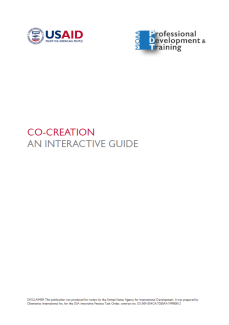Why Should You Use This Guide?
Co-creation can be transformative. Used properly, co-creation can turn USAID partners and stakeholders from passive receivers of development programming to active participants who shape priorities, design activities, and share ownership of USAID investments. Co-creation is an agency-wide priority goal that reinforces many USAID initiatives. It is essential to the Localization Agenda and Private Sector Engagement Policy. Co-creation processes were introduced to USAID through Broad Agency Announcements (BAAs) in 2012. Yet there remains a lot of confusion. Too often, co-creation is being misapplied or treated as a box-checking exercise, resulting in frustration within and outside USAID. When people hear co-creation, many think only about procurement processes and large workshops. Co-creation can be used in large or small groups, face-to-face or virtually, or even one-on-one with a partner. Co-creation is an intentional, time-bound approach that centers on shared power and decision-making for mutually beneficial outcomes. USAID staff can tailor co-creation tactics to fit their specific objectives across the program cycle.

